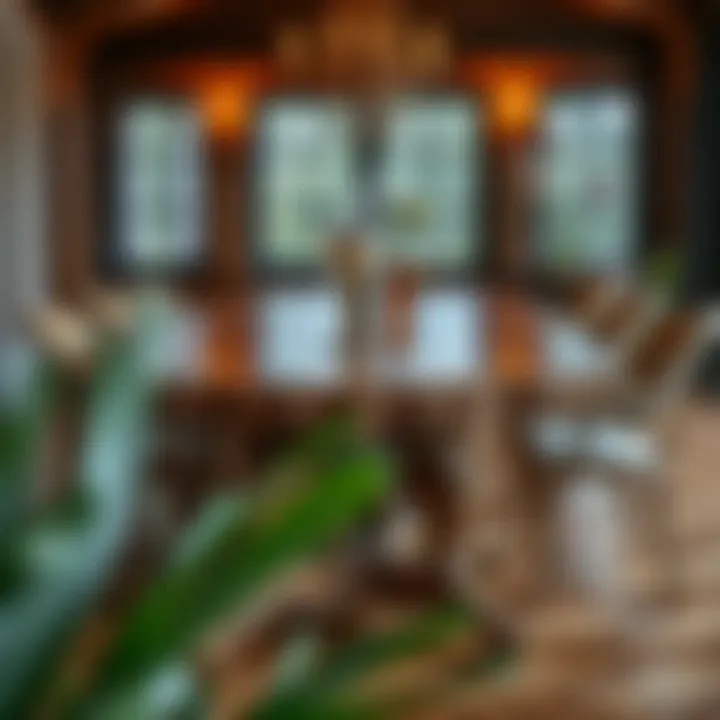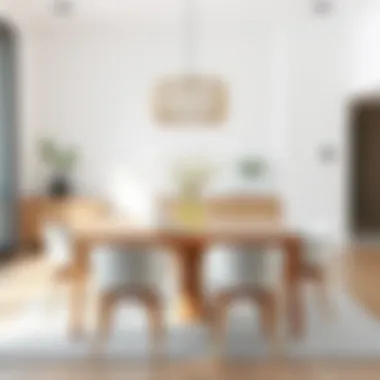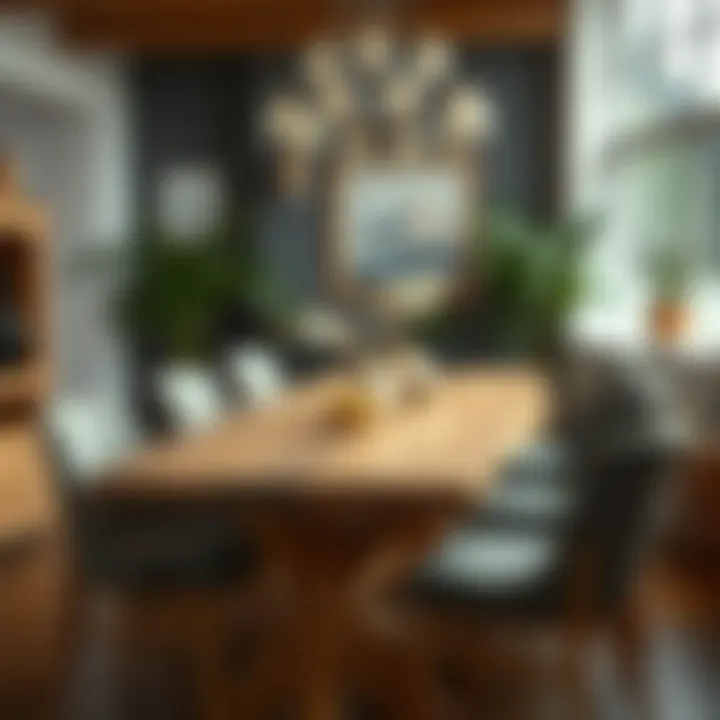In-Depth Guide to Wood Dining Table Designs


Intro
When it comes to crafting a warm and inviting ambiance in a home, the dining area often takes center stage. The choice of a wood dining table plays a pivotal role in shaping both the aesthetic and the functionality of that space. More than just a surface to serve food, these tables stand as the heart of family gatherings and socializing, breeding memories over meals.
From rustic farmhouse styles to sleek modern designs, the options seem endless. But understanding what each design conveys and the craftsmanship behind it can often feel overwhelming. This guide aims to walk you through the diverse landscape of wood dining table designs, highlighting the features that might just turn a simple piece of furniture into a conversation starter.
Not only will we explore popular current trends, but we will also dive into practical ideas for DIY enthusiasts and savvy homeowners looking to enhance their living spaces. Stick around; there’s a world of creativity and functionality waiting to be uncovered.
Prelude to Wood Dining Tables
Wood dining tables serve as the heart of many homes, where meals are shared, conversations sparked, and memories crafted. They are more than just furniture pieces; they embody family traditions and social interactions, influencing the atmosphere and appeal of any dining area. With their inherent warmth and natural beauty, wood dining tables come in a plethora of designs, styles, and finishes that cater to an array of tastes and needs.
When choosing a wood dining table, there are several key elements to consider. The durability of the material is crucial, especially if your household frequently hosts gatherings or if you have children. Hardwoods, for instance, typically offer robustness and longevity, making them a popular choice for dining tables. In contrast, softwoods might present lighter options at the cost of less durability, which might influence how one accommodates various dining experiences.
Furthermore, the design aesthetic of a dining table can enhance or detract from the overall decor of your home. From classic, ornate carvings to sleek, modern lines, each design can evoke different moods and impressions. It’s important to consider not just how a table looks but how it fits within your existing space and lifestyle. For example, families with small children might opt for tables with rounded edges and durable finishes, while young professionals might lean towards minimalist styles that emphasize clean lines and functionality.
Beyond mere aesthetics, the sustainability aspect of wood dining tables is garnering increased attention. With more consumers becoming eco-conscious, knowing where your wood comes from can make a significant difference. Many people now seek tables sourced from sustainably managed forests, ensuring that their purchase has a less harmful impact on the environment.
In summary, selecting a wood dining table encompasses a range of considerations, from durability and aesthetic appeal to sustainability. As we explore the various aspects of wood dining table designs in this article, keep these factors in mind. They all contribute to creating a warm, inviting space that complements your lifestyle while standing the test of time.
"Choosing the right dining table isn't just about functionality; it’s about crafting a space for connection and shared experiences."
Embedded knowledge about wood types, design styles, and maintenance tips will empower homeowners, designers, and DIY enthusiasts alike in making informed decisions that resonate with their individual preferences.
Understanding Different Types of Wood
When choosing a wood dining table, it’s crucial to understand the different types of wood available. This choice can greatly influence the table's durability, aesthetic appeal, and impact on the environment. Key attributes such as grain pattern, hardness, and color all come into play, affecting not only the look but also the feel of your dining space. Selecting the right type of wood is not merely an exercise in aesthetics; it's about making educated choices that align with your lifestyle and values.
Hardwoods vs. Softwoods
Characteristics of Hardwoods
Hardwoods come from deciduous trees, meaning they shed their leaves annually. A prime characteristic of hardwoods is their density; this makes them exceptionally durable and resistant to wear and tear. Common hardwoods used in furniture include oak, walnut, and cherry.
The dense nature of hardwoods contributes to their strength. For instance, oak is well-known for its durability, making it an ideal choice for families with children or active lifestyles. Their resilience also ensures that they can withstand daily use, resisting scratches and dents much better than their softer counterparts. However, hardwoods can come with a higher price tag, making them a significant investment.
Characteristics of Softwoods
Softwoods, on the other hand, typically originate from coniferous trees, which retain their needles throughout the year. A notable aspect of softwoods is that they tend to be lighter and easier to work with than hardwoods. Common types include pine, fir, and cedar.
Softwoods are often favored for their cost-effectiveness. For example, pine is frequently utilized in DIY projects due to its availability and relatively low price. While they may not hold up as well against heavy use as hardwoods, many choose softwoods for their lightness and warmth. That makes them a great option for those looking for a more rustic appeal. Just be mindful of their propensity to dent or scratch more easily than hardwoods.
Sustainable Sourcing of Wood
Importance of Eco-Friendly Choices
With growing awareness of environmental issues, making eco-friendly choices in wood sourcing matters more than ever. The origins of the wood used in dining tables can have a significant impact on forests and ecosystems. Choosing sustainably sourced wood supports responsible forestry practices and helps maintain biodiversity.
Moreover, selecting eco-friendly materials often reflects a personal commitment to sustainability. It not only benefits the environment but also enhances your dining experience, as you can dine with a clearer conscience. Additionally, many consumers report a strong preference for brands that focus on sustainability, which could influence your buying decision in a competitive market.
Certifications to Look For
When searching for sustainably sourced wood, it’s critical to check for proper certifications. Notable ones include the Forest Stewardship Council (FSC) and the Sustainable Forestry Initiative (SFI). These certifications provide assurance that the wood has been harvested responsibly.
Understanding these certifications can empower consumers. For instance, FSC-certified wood assures you that the timber was harvested in ways that meet social, economic, and ecological standards. It adds an extra layer of trust in your purchase. Overall, investing time to learn about these certifications allows buyers to make informed choices, promoting a healthier planet while also enhancing their living spaces.
Design Styles of Wood Dining Tables
When it comes to wood dining tables, design styles play an essential role. Not only do they reflect personal taste, but they also impact the overall dining experience. Different styles can set cozy, formal, or industrial vibes in a home, making it crucial to understand the available options. Furthermore, the design can influence how functions and aesthetics combine, allowing for practical use while still showcasing beautiful craftsmanship.
Traditional Designs
In the world of dining tables, traditional designs come packed with history and enduring style. They often represent timeless elegance, which fits seamlessly into various settings.
Classic Dining Sets
Classic dining sets often anchor family gatherings. Their key characteristic is robust craftsmanship, often hand-carved and meticulously finished. This craftsmanship ensures durability and a look that can complement most decor styles. Because of their sturdy nature, they become not just functional pieces but also cherished heirlooms.
Unique feature: Many classic tables feature ornate details—think scrollwork or intricately turned legs. Such features contribute to their appeal as they are not merely tables; they tell stories of artisanship. The advantage is that these tables can blend comfortably with a range of styles, from cozy homes to more sophisticated setups. However, they may not always suit modern minimalist spaces where simpler lines are preferred.
Rustic Finishes
Rustic finishes bring a homely, down-to-earth charm that appeals to many. They highlight natural imperfections, embracing knots and grains in the wood. This authenticity connects well with those who prefer a more laid-back atmosphere.
Key Characteristic: The rough-hewn aesthetic, often featuring a weathered look, provides warmth to dining experiences. Rustic finishes can serve well in casual dining areas or mountain lodges, making them a popular choice for many buyers aiming for coziness.


While they shine in their warm charm, a potential disadvantage may be the maintenance aspect. Rustic woods can show signs of wear more easily; thus, care must be taken to preserve their beauty over time.
Modern Interpretations
Modern interpretations of wood dining tables emphasize sleekness and functionality, embodying clean aesthetics.
Sleek Lines and Minimalism
Sleek lines and minimalism define modern designs. The essence lies in simplicity, often marked by smooth surfaces and precise geometry.
The key characteristic of these tables is their ability to create an uncluttered dining space and highlight the beauty of the wood. They work beautifully in contemporary homes that embrace open spaces with clean lines. Minimalist dining sets free up visual weight, promoting a sense of calm in the dining area.
However, a disadvantage can be that such designs may lack the warmth and character found in more traditional styles. Some homeowners may miss that cozy feeling when surrounded by colder, more geometric lines.
Mixed Materials
Mixed materials offer a fresh approach to wood dining tables, combining wood with metals or glass for unique aesthetics.
The appeal stems from its versatility; a wood top paired with metal legs can enhance sturdiness while providing a modern edge. This combo can serve as a conversation starter and stands out in any dining room.
The unique feature of mixed-material tables is their ability to mesh various elements from different design styles, appealing to many tastes and preferences. The advantage is broad appeal—these tables often attract those wanting to express their creativity in decor choices. On the downside, potential buyers should consider how the materials hold up over time in terms of scratches and wear.
Industrial Aesthetics
Industrial aesthetics bring forth a rugged yet stylish charm, fusing raw materials for an edgy look and feel.
Raw Finishes
Raw finishes emphasize the beauty of natural wood while remaining untouched. This raw look can invite a sense of authenticity, making it a popular choice for many seeking to showcase nature in their spaces.
The characteristic of raw finishes lies in their stark realism. They draw attention to imperfections and unique textures, contributing to a space filled with character. Their appearance feels more personalized compared to polished counterparts, making them stand out in urban or farmhouse settings.
One caution to consider is maintenance; raw finishes can require more attention to avoid damage from spills or scratches.
Metal Accents
Metal accents create a striking contrast to warm wood, adding a touch of industrial vibe. This trend melds seamlessly into contemporary and modern styles, bringing drama and sophistication.
The key characteristic is that metal can introduce varied textures and colors, enriching the visual palette of the dining area. By incorporating metal accents, tables can reflect more complex narratives, combining different eras and styles.
While this combination is beneficial, homeowners should keep in mind the balance of materials in order to avoid overwhelming the overall aesthetics of the room. Too much metal could potentially overshadow the warmth offered by the wood.
In summary, understanding the diverse design styles of wood dining tables guides homeowners towards choices that not only fit their practical needs but also enrich their living spaces with character and style.
Sizes and Shapes of Dining Tables
When it comes to dining tables, size and shape play pivotal roles in how the space is utilized. The dining table is often the centerpiece of family gatherings and meals. Thus, selecting the right size and shape is not just about aesthetics; it's also about functionality. You want a table that fits comfortably in your space, serves your needs, and complements the overall decor.
Choosing the right size ensures that everyone at the table can be seated comfortably without feeling cramped. The shape of the table, whether round, rectangular, or square, can influence the flow of movement around it and how people engage with each other during meals. Each type of table has its unique benefits and can fit various settings, whether it's a small apartment or a large dining room. Let’s dive deeper into the specific shapes of dining tables and understand why they matter for both functionality and design.
Round Tables: A Closer Look
Advantages of Round Dining Tables
Round dining tables are often praised for their ability to create a sense of intimacy. There's no head of the table, which promotes an equal conversation dynamic among everyone seated. This characteristic is especially beneficial for gatherings, as it encourages interaction. The radial shape also often takes up less space visually, making it feel less imposing in smaller dining areas.
Another advantage is their adaptability in layout. Round tables can easily fit into corners, or they can be expanded with the addition of leaves when necessary. This makes them a popular choice for those who frequently entertain. If you're keen on creating a cozy atmosphere, round tables are probably a smart pick.
Best Fits for Small Spaces
When considering options for smaller dining environments, round tables really shine. Their shape allows for closer seating, minimizing the need for excessive space around the edges. This makes them ideal for apartments or compact dining nooks. Furthermore, round models typically come in various sizes, meaning you can find a table that perfectly fits your space without overwhelming it. A compact round table can transform a small area into a cozy dining spot, providing an inviting atmosphere without sacrificing your ability to entertain.
Rectangular Tables: Practical Use
Seating Capacity Considerations
Rectangular tables commonly accommodate larger groups, making them a go-to choice for families and those who host frequent gatherings. They can easily seat more people than their round counterparts and often come in various lengths, allowing for versatile seating arrangements. When purchasing a rectangular table, you can consider how many people typically gather for meals and choose according to your needs.
An added benefit of rectangular tables is that they often offer extra surface area for serving dishes, keeping everything within reach. That said, it’s essential to balance the dimensions of the table with the room's available space. A large table in a small room can feel cramped and uninviting.
Functionality for Activities
Beyond dining, rectangular tables are adept at serving other purposes. Whether it’s a game night with friends or a creative project with family, their length allows for productive use beyond meals. The flat surface acts as a great workspace, and when it’s time for dining, the table can neatly transition from a workspace to a dining area. This multi-functional aspect makes rectangular tables a wise investment for active households.
Square vs. Oval Tables


Choosing the Right Shape
When it comes to square versus oval tables, the choice often boils down to space and aesthetics. Square tables provide a balanced look and work well in small dining rooms or kitchens. They can easily accommodate four people, making them a good choice for intimate settings. However, they might not be as practical for larger groups, unless you opt for a very large model.
Oval tables, on the other hand, offer the same seating benefits as rectangular tables but with a softer appearance. They can fit into tight spaces more seamlessly and provide a unique aesthetic that can elevate a dining area’s décor. Additionally, oval shapes can reduce the elbow-to-elbow distance while dining, enhancing comfort.
Design Impact on Dining Experience
Shape plays an influential role in the overall dining experience. The layout of your dining area and how you engage with one another can vary significantly depending on the table’s shape. A square table can foster closeness, while an oval table can create a flow that encourages conversation. The choice of table shape should not just prioritize function but take into account the atmosphere you wish to create during meals.
The shape of your dining table can profoundly affect the dynamics of conversation and interaction during meals.
Finish Options for Wood Dining Tables
Choosing the right finish for wood dining tables is not just about aesthetics; it plays a critical role in durability, maintenance, and overall impact on the dining experience. The finish you select can either enhance or diminish the natural beauty of the wood. Moreover, different finishes cater to varied lifestyles and design preferences, making this aspect an essential consideration for homeowners, designers, and anyone looking to invest in a quality dining table. Understanding your options can help you make a more informed choice that reflects both style and function.
Natural Finishes: Emphasizing Grain
Advantages of Natural Oils
Natural oils, such as linseed or tung oil, offer a unique allure to wood dining tables, enhancing the grain and warmth of the wood while providing a protective layer. One of the primary benefits of using natural oils is their ability to penetrate the wood, offering a finish that not only looks good but also provides moisture resistance. This permeability allows the wood to breathe, reducing the risk of cracking or warping over time, which is invaluable for a piece that likely sees regular use.
The non-toxic nature of these oils makes them a favored choice for many, particularly those who are health-conscious or have young children in the home. However, it's important to note that while natural oils can create a beautiful finish, they may require more frequent reapplication compared to synthetic finishes, which could be seen as a downside. Regular maintenance ensures that the surface continues to look vibrant and remains protected, allowing the unique characteristics of the wood to shine through.
Maintenance Tips
Maintaining a natural finish on wood dining tables is vital for prolonging the life and appearance of the piece. One key characteristic of natural finishes is their requirement for gentle cleaning methods. Regular dusting with a soft, dry cloth can help prevent grime buildup. For deeper cleaning, using a mixture of warm water and mild soap is advisable, but the cloth should be wrung out thoroughly to avoid excess moisture on the wood.
A unique aspect of caring for these finishes is the use of specialized oils for conditioning. Applying a very light coat of oil every six to twelve months can keep the surface nourished. However, one must ensure to avoid the common pitfall of over-oiling, which can lead to a sticky residue and attract dust. Although this maintenance might seem tedious to some, the rewards of preserving a natural look that ages beautifully are well worth the effort.
Painted Finishes: A Bold Choice
Color Psychology
Painted finishes open a whole new world of possibilities for wood dining tables. The colors chosen can dramatically influence the mood of the dining area. For instance, warm tones like reds and oranges can evoke feelings of coziness and comfort, making them ideal for family gatherings or intimate dinners. In contrast, cooler shades like blues and greens might promote a sense of calm and tranquility, which can be perfect for a more relaxed dining experience.
Paint can also serve as a statement piece in any dining setup, adding vibrancy or sophistication depending on the hue selected. However, one must consider the implications of color psychology here—it’s not merely about aesthetics; the color can affect emotions, interactions, and even the social dynamics during mealtime. Choosing the right color thus becomes a thoughtful process, aligning with personal style as well as emotional ambiance.
Durability Considerations
The durability of painted finishes is another critical aspect. Unlike natural oils, which may wear away over time, a good quality paint can offer a more resilient surface against scratches and spills. This is especially valuable in homes with children or pets, where accidental marks are likely. Paints that come with a protective topcoat or are specifically designed for high-use surfaces can endure challenging conditions, ensuring the table remains a centerpiece for many years.
Nevertheless, it's worth pointing out that even painted finishes can face their share of drawbacks. Over time, they can chip or fade due to exposure to sunlight and regular use. Maintenance might involve periodic touch-ups or even a complete repaint to maintain the table's appearance. While painted finishes can provide a bold look and functional benefits, the effort to preserve their integrity shouldn’t be overlooked. In the end, the choice between natural and painted finishes boils down to a balance of aesthetics, maintenance, and durability priorities.
Combining Functionality with Aesthetics
In the realm of wood dining tables, blending functionality with aesthetics is a key theme that resonates deeply with homeowners, designers, and DIY enthusiasts alike. It offers a comprehensive approach to creating spaces that not only look good but also serve their purpose effectively. The aesthetic appeal of a dining table goes hand in hand with its usability, influencing the dining experience and overall ambiance of a home.
Multi-Functional Tables
Expanding for Larger Gatherings
An expanding dining table is like a faithful friend that adapts to your needs, easily transitioning from a cozy dinner for two to a festive gathering of family and friends. This flexibility is an invaluable characteristic, especially for those who enjoy hosting events or have unpredictable guest counts. Expanding tables often come equipped with hidden leaves that can be drawn out or added in as needed, making them a popular choice.
They not only maximize space but also provide a unified feel in your dining area. However, it’s worth noting that not all expanding tables are created equal; some may have a more cumbersome mechanism that needs careful handling. Despite this minor drawback, the benefits of accommodating larger gatherings undeniably enhance the dining experience.
Storage Solutions
When it comes to maximizing space in a dining area, ingenuity shines through with clever storage solutions. Tables that incorporate built-in storage, such as drawers or shelves, allow homeowners to stow away dining essentials like linens and utensils, keeping the area tidy. This attribute makes it a practical choice, particularly for smaller homes or apartments that often lack additional storage options.
Imagine reaching into a neatly concealed drawer to fetch your favorite napkin set just as guests arrive. This functionality not only elevates convenience but also heightens the aesthetic appeal by keeping clutter at bay. However, relying too much on these designs may sometimes compromise the table’s styling, creating a slightly bulkier look. In essence, such storage features serve a dual role: they keep items organized while adding utility to surface area that might otherwise remain unenjoyed.
Styling with Wood Tables
Complementary écor
Choosing decor that complements a wood dining table can transform the entire space. The warm tones of wood, whether it's oak, walnut, or cherry, can harmonize beautifully with a variety of styles. This appealing aspect makes it a favored choice for many. Utilizing colors and materials that resonate well with the natural wood can create an inviting atmosphere.
Imagine pairing a rich mahogany table with soft linen tablecloths and vintage tableware — it all works together. However, one must approach this thoughtfully; over-cluttering a table with too many elements can detract from its visual charm. The beauty lies in balance, and mindful selection of décor can turn a simple wood table into a centerpiece.
Table Settings and Accessories
Table settings and accessories play a pivotal role in enhancing the dining experience and can reflect the overall theme of the home. Incorporating tasteful centerpieces, elegant dishware, and thoughtful place settings not only showcases personal style but also enhances the table’s functionality.
Well-chosen accessories can encourage a particular ambiance, be it casual or formal, by enhancing the table’s purpose. An issue arises, though, when accessories overpower the table itself; it can leave guests feeling overwhelmed amidst an excess of decor. Striking the right balance is essential, ensuring that the settings enrich the experience without overshadowing the simple beauty that a wooden table inherently brings.


"A dining table is more than just a piece of furniture; it’s a place where memories are made and shared. Functionality and aesthetics together make it the heart of the home."
So, in the end, the beauty of wood dining tables lies not just in their design but in how they bring people together, blending form and function seamlessly to enhance both utility and style.
Caring for Wood Dining Tables
Caring for wood dining tables is crucial for their longevity and aesthetic appeal. Like any quality piece of furniture, proper maintenance ensures that these tables remain functional and visually pleasing over time. By understanding the best practices for care and maintenance, homeowners can enhance the life of their table while preserving its natural beauty. Good care routines not only protect the wood from damage but also keep it looking fresh and inviting for gatherings, family meals, or casual afternoon coffees.
Routine Maintenance
Routine maintenance of wood dining tables is essential for avoiding damage and keeping the table in top shape. A simple, consistent routine can save time and money on repairs down the line, allowing for an enjoyable dining experience.
Cleaning Techniques
When it comes to cleaning wood tables, less is often more. Using a soft, damp cloth is usually enough to remove dust and debris without scratching the surface. It’s crucial to avoid harsh chemicals like bleach or ammonia that can strip away the finish. Instead, a gentle mix of mild soap and water provides an effective solution. For deeper cleans, natural solutions like vinegar diluted in water are beneficial, reducing buildup while being eco-friendly.
A key characteristic of these cleaning methods is their simplicity; they allow for quick responses to spills or stains. The unique feature here is the protection of the table’s finish from harmful products. This method is often hailed as a safe approach that guards against damage, only utilizing materials that do not interfere with the wood’s integrity, making it a popular choice among homeowners.
Polishing and Conditioning
Polishing and conditioning is another vital aspect of caring for wood tables. This process revitalizes the wood, bringing back its luster and enhancing the grain's appearance. Using a quality wood polish designed for the specific type of wood can seal the surface, providing a barrier against scratches and moisture. It’s generally recommended to polish every few months to maintain a beautiful sheen.
The key characteristic here is the hydration of the wood, which prevents drying and cracking—common issues in untreated furniture. One unique feature of using polish is the range of scents offered, contributing to an overall pleasant atmosphere in the dining area. However, it’s wise to be cautious about over-polishing, which can lead to a sticky residue.
Repairing Common Damages
Despite the best maintenance practices, wear and tear can occur. Knowing how to handle common damages can save a table from becoming an eyesore and extend its life.
Dealing with Scratches
Scratches on a wood dining table are frustrating but not entirely unavoidable; they can result from everyday use. Thankfully, dealing with them can be straightforward. For minor scratches, a simple trick is to use a walnut or almond; the oils from the nuts can fill in small scratches quite effectively. For deeper scratches, wood filler can come to the rescue, followed by sanding the area and applying finish for an even look.
The characteristic appeal of this approach is that it allows for a quick fix without extensive costs. The unique feature here is the use of natural products found within homes, making it both economical and resourceful. Homeowners find this beneficial, as it minimizes downtime and effort.
Water Stain Remedies
Water stains on wood can be unsightly and may require specific treatments. For instance, a mixture of equal parts baking soda and water can create a paste that gently lifts stains without damaging the finish. Another method includes placing a cloth over the stain and applying a warm iron briefly; heat can help lift moisture trapped underneath the finish.
The key here is understanding how moisture affects wood and knowing these methods can significantly help. This approach utilizes common household items accessible to almost anyone, often viewed as both effective and budget-friendly. The gentle nature ensures the wood isn't harmed, a unique feature that appeals to many as they tackle everyday mishaps.
In summary, taking the time to properly care for wood dining tables is invaluable. By implementing routine cleaning, polishing, and knowing how to remedy common damages, homeowners can maintain the beauty and functionality of their tables, ensuring that they remain a central piece in their homes for years to come.
Popular Wood Dining Table Designs: Inspiration Gallery
An inspiration gallery plays a pivotal role in the selection process of wood dining tables, as it allows individuals to visualize their options within the vast world of design. When looking for a dining table, seeing various styles can spark creativity and help in narrowing down choices. The diversity presented in such galleries can connect with different aesthetic senses and functional requirements.
Gallery of Traditional Styles
Traditional wood dining tables bring a sense of timeless elegance to any setting. These designs often showcase craftsmanship that has stood the test of time, using techniques passed down through generations. Solid oak, cherry, and walnut are common choices for these tables, lending durability and beauty. Key characteristics include intricate carvings, detailed moldings, and rich finishes that highlight the natural grain of the wood. They often include:
- Classic Pedestal Bases: A round table supported by a single large pedestal, encouraging a cozy dining atmosphere.
- Extendable Leaves: Features allowing for extra seating during gatherings, ensuring versatility and practicality in design.
- Finely Crafted Details: Think about elegant aprons, distressed finishes, or even hand-carved legs, enhancing their overall charm.
Showcasing Modern Trends
Modern wood dining table designs take a different route, often prioritizing minimalism and clean lines. They break traditional molds while still using warm wood tones, fostering a contemporary yet inviting atmosphere. Designers now incorporate innovative shapes and materials to create stunning visual contrasts. Elements of modern designs often include:
- Sleek, Unadorned Surfaces: Focus on symmetry and simplicity in forms, allowing for a functional yet stylish appeal.
- Mixed Materials: Combining wood with metal or glass can produce striking combinations, appealing to those who prefer a blend of aesthetics.
- Natural Finishes: Rather than hiding the wood's natural beauty, these tables often highlight imperfections and textures, showcasing uniqueness.
Industrial Inspirations
Inspired by the raw, rustic look of urban spaces, industrial wood dining tables reflect a bold statement. They blend the rough and the refined, emphasizing the beauty that comes with imperfections. These designs often feature:
- Reclaimed Wood: Adding character and history, tables made from reclaimed timber not only reduce waste but also provide a distinctive look.
- Metal Accents: Bases and frames made of steel or iron can add an edgy touch, contrasting sharply with the warmth of the wood.
- Rough Finishes: Often, these tables retain a raw essence by highlighting knots, scratches, and natural textures, perfect for those who appreciate authenticity.
A well-crafted wood dining table is not just furniture; it's an investment in the home, a place where memories are formed and connections are strengthened. Each style offers a glimpse into the story it can tell.
In essence, the inspiration gallery for wood dining tables showcases the versatility of wood in design, offering a rich palette from traditional elegance to modern minimalism, and rugged industrial styles. Homeowners and designers can explore these distinct categories to find the perfect piece that resonates with their aesthetic and functional needs.
Finale and Final Thoughts
In the exploration of wood dining tables, we have traversed a landscape rich with design options, materials, and styles. Understanding the nuances of wood types, the aesthetics of various designs, and practical considerations can significantly enhance your dining experience and transform your living space.
The piece emphasizes several key elements:
- Craftsmanship Matters: It’s not merely about choosing a table; it’s about selecting a piece that will endure and add character to your home. Each table has a story—from the grains of the wood to the artisan's touch. Paying attention to craftsmanship can make a world of difference in quality and longevity.
- Sustainability: As we lean towards eco-friendliness, the importance of sustainable sourcing comes into play. By opting for wood that is certified or salvaged, you contribute to a healthier planet while ensuring your ethically-sourced table can enhance both style and consciousness in your home.
- Functional Designs: Beyond aesthetics, the functionality of the table shapes and sizes ought to be considered. The right table should not only seat friends and family but also serve as a workspace or offer storage solutions. Multi-functional tables are increasingly desirable in today’s homes where space might be limited.
- Ongoing Care: Lastly, maintaining your wood dining table is crucial. Regular cleaning, appropriate sealing techniques, and knowledge of repair methods can keep your table in prime condition. It’s worth remembering that wood is a living material, requiring some attention to remain in optimal shape.
A well-chosen dining table is more than furniture; it’s a gathering spot, a part of family history, and a centerpiece for your home.
In closing, selecting the ideal wood dining table is an art and a science, merging aesthetics with practical needs. As you embark on this journey, remember the significance of your choice. It’s an investment not just in style, but in the memories that will be created around it. Engage with diverse styles and options, reflecting on what aligns with your lifestyle.
For further information or inspiration regarding wood dining tables, you can explore resources such as Wikipedia, Britannica, or home design platforms like Reddit to connect with communities who share your interests.















